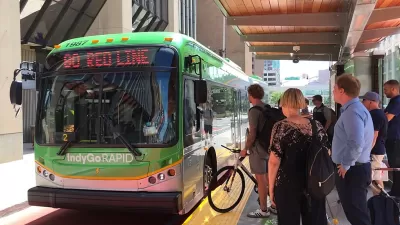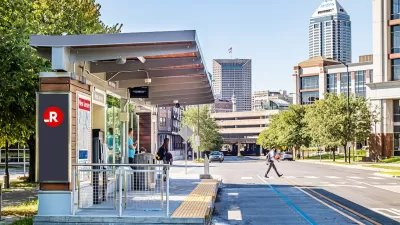IndyGo is planning changes to the Blue Line. The city’s third bus rapid transit route is turning out to be much more expensive than originally expected.

“IndyGo is considering changes to the route for the Blue Line, the transit agency's third bus rapid transit line connecting Cumberland to the Indianapolis International Airport, in light of ballooning project cost estimates,” reports Kayla Dwyer for the Indianapolis Star.
Labor shortages and supply chain issues are blamed for increasing estimated costs on the project from $220 million in 2019 to $520 million in 2022. “Another major cost increase is attributable to city and Citizens Energy Group standards for drainage that have changed since work on the Blue Line began in 2018,” according to a source cited by Dwyer in the article. “Drainage costs alone comprise 42% of the total construction cost, whereas they comprised 18% of the Purple and Red Line costs.”
“To cut costs, IndyGo is proposing diverting the bus rapid transit route to I-70 between Holt Road and the airport, rather than using Washington Street,” reports Dwyer. “That would save in capital costs and travel time to the airport, but it would also mean no new stops west of Holt Road and no immediate infrastructure improvements to that stretch of Washington Street, unless the city or IndyGo pursues these in a separate project.”
More details on how much money each of the proposed changes would save are included in the source article below.
FULL STORY: Ballooning costs force IndyGo to rethink Blue Line design; here's what might change.

Trump Administration Could Effectively End Housing Voucher Program
Federal officials are eyeing major cuts to the Section 8 program that helps millions of low-income households pay rent.

Planetizen Federal Action Tracker
A weekly monitor of how Trump’s orders and actions are impacting planners and planning in America.

Ken Jennings Launches Transit Web Series
The Jeopardy champ wants you to ride public transit.

California Invests Additional $5M in Electric School Buses
The state wants to electrify all of its school bus fleets by 2035.

Austin Launches $2M Homelessness Prevention Fund
A new grant program from the city’s Homeless Strategy Office will fund rental assistance and supportive services.

Alabama School Forestry Initiative Brings Trees to Schoolyards
Trees can improve physical and mental health for students and commnity members.
Urban Design for Planners 1: Software Tools
This six-course series explores essential urban design concepts using open source software and equips planners with the tools they need to participate fully in the urban design process.
Planning for Universal Design
Learn the tools for implementing Universal Design in planning regulations.
Ada County Highway District
Clanton & Associates, Inc.
Jessamine County Fiscal Court
Institute for Housing and Urban Development Studies (IHS)
City of Grandview
Harvard GSD Executive Education
Toledo-Lucas County Plan Commissions
Salt Lake City
NYU Wagner Graduate School of Public Service




























